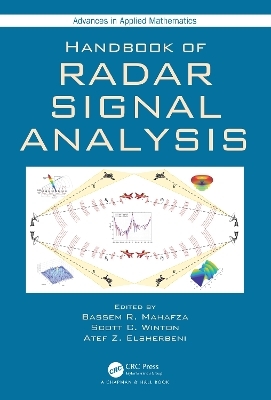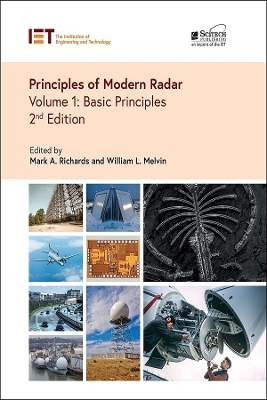
Handbook of Radar Signal Analysis
CRC Press (Verlag)
978-1-138-06286-3 (ISBN)
This new handbook on radar signal analysis adopts a deliberate and systematic approach. It uses a clear and consistent level of delivery while maintaining strong and easy-to-follow mathematical details. The emphasis of this book is on radar signal types and their relevant signal processing and not on radar systems hardware or components.
This handbook serves as a valuable reference to a wide range of audience. More specifically, college-level students, practicing radar engineers, as well as casual readers of the subject are the intended target audience of the first few chapters of this book. As the book chapters progress, these grow in complexity and specificity. Accordingly, later chapters are intended for practicing engineers, graduate college students, and advanced readers. Finally, the last few chapters contain several special topics on radar systems that are both educational and scientifically entertaining to all readers.
The presentation of topics in this handbook takes the reader on a scientific journey whose major landmarks comprise the different radar subsystems and components. In this context, the chapters follow the radar signal along this journey from its birth to the end of its life. Along the way, the different relevant radar subsystems are analyzed and discussed in great detail.
The chapter contributors of this new handbook comprise experienced academia members and practicing radar engineers. Their combined years of academic and real-world experiences are in excess of 175. Together, they bring a unique, easy-to-follow mix of mathematical and practical presentations of the topics discussed in this book. See the "Chapter Contributors" section to learn more about these individuals.
Bassem R. Mahafza, Scott C. Winton, Atef Z. Elsherbeni
Chapter 1. Signal and Systems - A Refresher. 1.1. Signal Classification. 1.2. Signal Expansion Functions. 1.3. The Fourier Transform. 1.4. Systems Classification. 1.5. Spectra of Common Radar signals. 1.6. Convolution Integral. 1.7. Correlation. 1.8. Bandpass Signals. 1.9. Discrete Time Systems and Signals. 1.10. The Z-Transform. 1.11. The Discrete Fourier Transform. 1.12. Random Variable and Random Processes. Chapter 2: Radar Systems Basics. 2.1. Radar Block Diagram. 2.2. Radar Specific Terms. 2.3. Radar Systems Classifications and Bands. 2.4. Decibel Arithmetic. 2.5. Electromagnetic Wave (RF) Waves. 2.6. Coherence. 2.7. The Radar Antenna. 2.8. Radar Cross Section (RCS). 2.9. Radar Measurements Errors. Chapter 3: The Radar Equation. 3.1. The Radar Range Equation. 3.2. Bistatic Radar Equation. 3.3. Radar Losses. 3.4. Noise Figure. 3.5. Continuous Wave (CW) Radars. Chapter 4: Radar Propagation Medium. 4.1. The Earth’s Impact on the Radar Equation. 4.2. Earth’s Atmosphere. 4.3. Atmospheric Models. 4.4. Four-Third Earth Model. 4.5. Ground Reflection. 4.6. The Pattern Propagation Factor. 4.7. Diffraction. Chapter 5: Radar Electronic Warfare Techniques. 5.1. Electronic Warfare Classes. 5.2. Passive Jamming Techniques. 5.3. The Radar Equation with Jamming. 5.4. Noise (Denial) Jamming Techniques. 5.5. Deceptive Jamming. 5.6. Electronic Counter-Counter (ECCM) Techniques. 5.7. Case Studies. Chapter 6: The Matched Filter Receiver. 6.1. The Matched Filter. 6.2. General Formula for the Output of the Matched Filter. 6.3. Waveform resolution. 6.4. Range and Doppler Uncertainty. 6.5. Combined Range-Doppler Uncertainty. 6.6. Target Parameter Estimation. 6.7. Pulse Compression. Chapter 7: The Radar Ambiguity Function. 7.1. Ambiguity Function Definition. 7.2. Effective Signal Bandwidth and Duration. 7.3. Single Pulse Ambiguity Function. 7.4. LFM Ambiguity Function. 7.5. Coherent Pulse Train Ambiguity Function. 7.6. Pulse train with LFM Ambiguity Function. 7.7. Stepped Frequency Waveform Ambiguity Function. 7.8. Nonlinear Frequency Modulation (NLFM). 7.9. Ambiguity Diagram Contours. 7.10. Discrete Code Signal Representation. 7.11. Phase Coding. 7.12. Frequency Codes. Chapter 8: Target Detection. Part I - Single Pulse Detection. 8.1. Single Pulse with Known Parameters. 8.2. Single Pulse with Known Amplitude and Unknown Phase. Part II - Detection of Fluctuating Targets. 8.3. Pulse Integration. 8.4. Probability of Detection Calculation. 8.5. Cumulative Probability of Detection. 8.6. Constant False Alarm Rate (CFAR). 8.7. M-out-of-N Detection. 8.8. The Radar Equation Revisited. 8.9. The Incomplete Gamma Function. Chapter 9: Radar Signal Processing in Clutter. 9.1. Introduction. 9.2. Clutter Definition. 9.3. Volume Clutter. 9.4. Area Clutter. 9.5. Clutter RCS, Ground-Based. 9.6. Amplitude Distribution. 9.7. Area Clutter Spectrum. 9.8. Doppler Processing. 9.9. Moving Target Indicator. 9.10. Pulse Doppler Processing. 9.11. Ambiguity Resolution. 9.12. Limitations of Doppler Processioning. Appendix 9-A: Fill Pulses in Pulse Doppler Radars. 9-A.1. Range and Doppler Ambiguities. 9-A.2. Overview of Fill Pulses. 9-A.3. Pulse Doppler Waveform with Fill Pulses. 9-A.4. Recovery of Fill Pulses. 9-A.5. Doppler Filter Fill Pulses. 9-A.6. Caveats and Extension. Chapter 10: Radar Tracking. 10.1. Introduction. 10.2. Basic Concepts. 10.3. Measurements. 10.4. Filtering. 10.5. Derivation of Recursive Least Squares. 10.6. Data Association. 10.7. Tracking Maneuvering Targets. Chapter 11: Canonical and Finite Difference Time Domain Methods for RCS Computations. 11.1. Radar Cross Section (RCS) Definition. 11.2. RCS Dependency on Aspect Angle and Frequency. 11.3. Target Scattering Matrix. 11.4. Scattering off Basic Canonical Objects. 11.5. RCS Approximation of Simple Objects. 11.6. RCS Computational Electromagnetics. 11.7. Simulations using the FDTD Method. Chapter 12: Integral and Physical Optics Methods for RCS Computation. 12.1. Introduction. 12.2. Radiation and Scattering. 12.3. Numerical Methods. 12.4. RCS Data Products. 12.5. Scattering Coordinate System. 12.6. Examples. Chapter 13: Antennas for Radar Applications. 13.1. Antenna types. 13.2. Antenna Basic Parameters. 13.3. General Array Antennas. 13.4. Linear Arrays. 13.5. Array Tapering. 13.6. Planar Arrays. 13.7. Three- Dimensional Arrays. 13.8. Array Feeding and Beamforming Networks. Chapter 14: Synthetic Aperture Radar (SAR). 14.1. Basic Strip-Mode Synthetic Aperture (SAR) Concept. 14.2. SAR Image Formation. 14.3. Image Quality Considerations. 14.4. Spotlight SAR. 14.5. Inverse Synthetic Aperture Radar (ISAR). Chapter 15: Wideband Radar Applications. 15.1. Introduction. 15.2. Bands Versus Bandwidth. 15.3. Wideband Radar Applications. Chapter 16: Modern Digital Array Antennas for Radar Applications. 16.1. Introduction. 16.2. Introduction to Digital Arrays. 16.3. Comparison of Array Antenna Architectures by Example. 16.4. Other Digital Array Advantages. 16.5. Extreme Data Rates Demands in Digital Arrays. 16.6. Digital Down Conversion and Digital Up Conversion. 16.7. Array Factor versus Huygens-Fresnel Principle. 16.8. Simultaneous Receive Beams. 16.9. Array Scanning Effects to Array Pattern. 16.10. Noise Figure and Third Order Intercept in AESA. 16.11. Concluding Remarks.
| Erscheinungsdatum | 23.06.2021 |
|---|---|
| Reihe/Serie | Advances in Applied Mathematics |
| Zusatzinfo | 25 Tables, black and white; 569 Line drawings, black and white; 1 Halftones, black and white; 570 Illustrations, black and white |
| Verlagsort | London |
| Sprache | englisch |
| Maße | 178 x 254 mm |
| Gewicht | 1378 g |
| Themenwelt | Technik ► Nachrichtentechnik |
| ISBN-10 | 1-138-06286-3 / 1138062863 |
| ISBN-13 | 978-1-138-06286-3 / 9781138062863 |
| Zustand | Neuware |
| Informationen gemäß Produktsicherheitsverordnung (GPSR) | |
| Haben Sie eine Frage zum Produkt? |
aus dem Bereich


